Artist Paul Gauguin Location Musée d'Orsay Media glazed stoneware | Dimensions 75 cm x 19 cm Created 1894–1895 | |
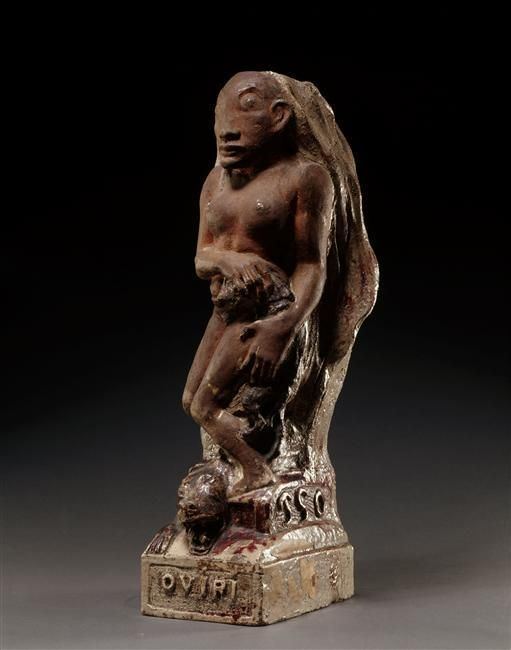 | ||
Similar Paul Gauguin artwork, Artwork at Musée d'Orsay, Other artwork | ||
Oviri (Tahitian: Savage or wild) is an 1894 ceramic sculpture by French artist Paul Gauguin, the original cast is in the Musée d'Orsay. Gauguin shows her with long pale hair and large wild eyes. In Tahitian mythology Oviri was the goddess of mourning. Gauguin shows her either smothering or embracing a wolf with her feet, as she tightly clutches another wolf cub in her arms. Art historians have presented multiple interpretations of the work; usually that he intended it as an epithet to reinforce his self-image as a "civilised savage". Tahitian goddesses of her era had passed from folk memory by 1894, yet Gauguin romanticises the island's past as he reaches towards more ancient sources, including an Assyrian relief of a 'master of animals' type and Majapahit mummies. Other possible influences include preserved skulls from the Marquesas Islands, figures found at Borobudur, and a 9th-century Mahayana Buddhist temple in central Java.
Contents
- Background
- Interpretation
- Tahiti deity
- Colonial experience
- Self portrait
- Reception and influence
- References

Gauguin made three casts in 1894, each in partially glazed stoneware. Several other copies exist in plaster or bronze. His sale of the casts were not successful, and at a low financial and personal ebb he asked that for one of the reproductions to act as a marker for his grave. A cast was not placed there until 1973. There are only three other surviving comments of his on the figure: on an 1895 presentation mount of two impressions of a woodcut of the Oviri figure he made to Stéphane Mallarmé where he called the figure a strange and cruel enigma; in an 1897 letter to Ambroise Vollard where he referred to it as La Tueuse ("The Murderess"); and in a c. 1899 drawing where he appends an inscription referencing Honoré de Balzac's novel Séraphîta. Oviri was exhibited at the 1906 Salon d'Automne (no. 57) where it influenced Pablo Picasso, who based one of the figures in Les Demoiselles d'Avignon on it.
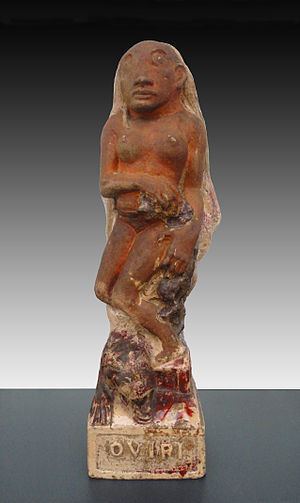
Background
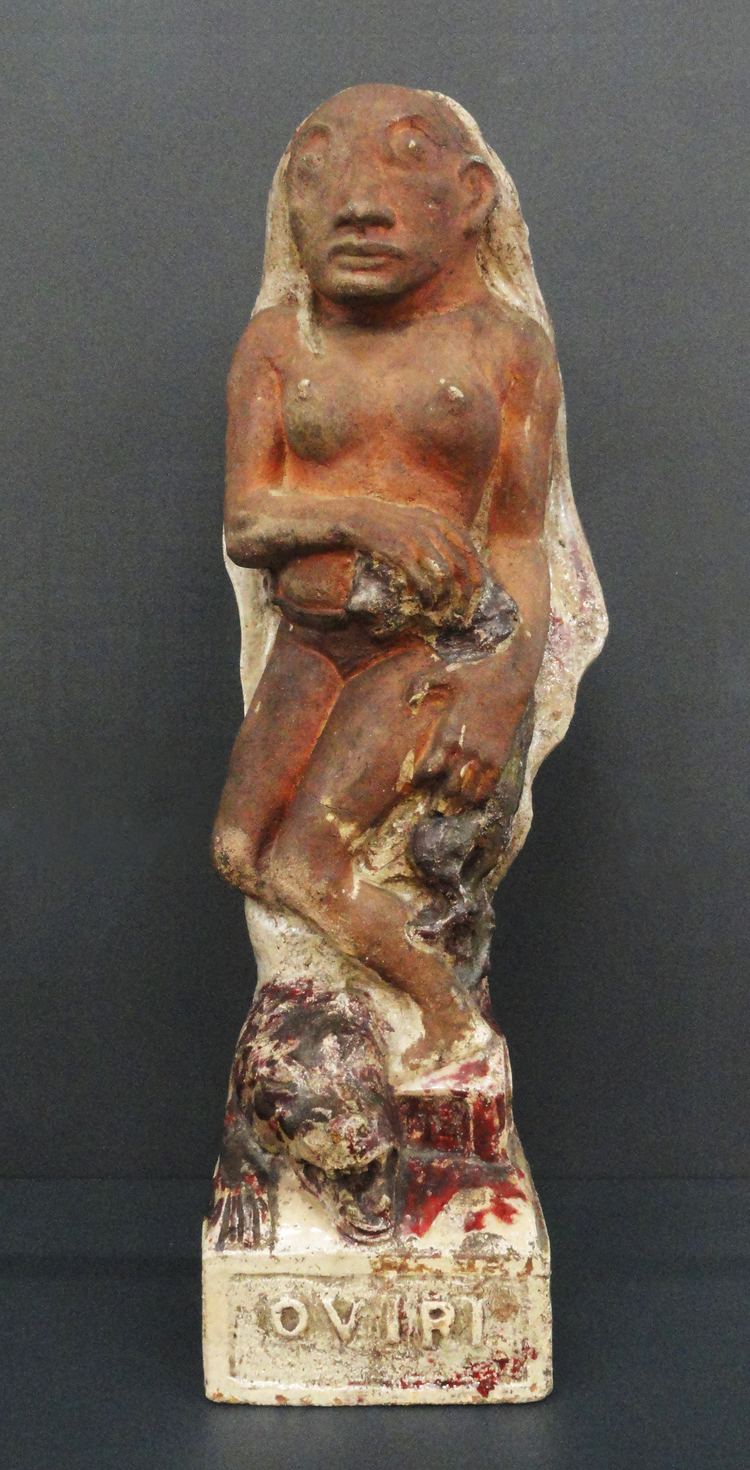
Gauguin was foremost a painter; he came to ceramics around 1886, when he was taught by the French sculptor and ceramist Ernest Chaplet. They had been introduced by Félix Bracquemond who, inspired by the new French art pottery, was experimenting with the form. During that winter of 1886–87, Gauguin visited Chaplet's workshop at Vaugirard, where they collaborated on stoneware pots with applied figures or ornamental fragments and multiple handles.

Gauguin first visited Tahiti in 1891, and attracted by the beauty of Tahitian women undertook a set of sculptural mask-like portraits on paper. They evoke both melancholy and death, and conjure the state of faaturuma (brooding or melancholy); imagery and moods later used in the Oviri ceramic. Gauguin's first wood carvings in Tahiti were with a guava wood that quickly crumbled and have not survived.
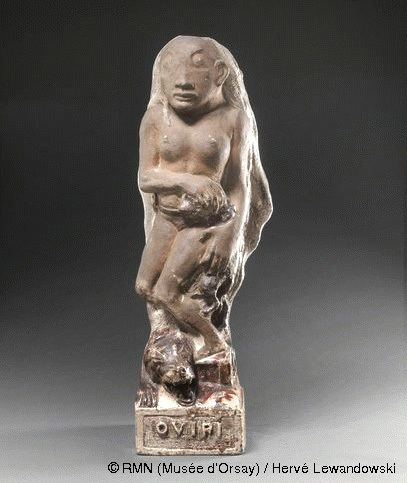
He completed Oviri in the winter of 1894, during his return from Tahiti, and submitted it to the Société Nationale des Beaux-Arts 1895 salon opening in April the following year. There are two versions of what ensued: Charles Morice claimed in 1920 that Gauguin was "literally expelled" from the exhibition; in 1937 Ambroise Vollard wrote that the piece was admitted only when Chaplet threatened to withdraw his own works in protest. According to Danielsson, Gauguin was keen to increase his public exposure and availed of this opportunity by writing an outraged letter to Le Soir, bemoaning the state of modern ceramics.
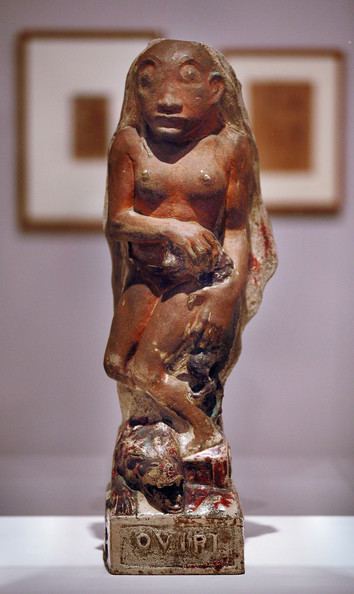
At the outset of 1897, Vollard addressed a letter to Gauguin about the possibility of casting his sculptures in bronze. Gauguin's response centered on Oviri:
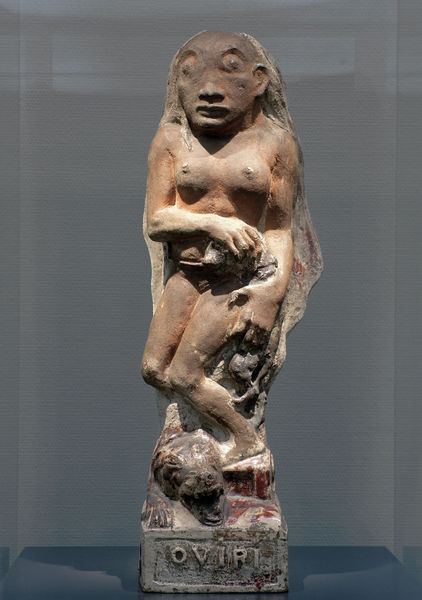
I believe that my large statue in ceramic, the Tueuse ("The Murderess"), is an exceptional piece such as no ceramist has made until now and that, in addition, it would look very well cast in bronze (without retouching and without patina). In this way the buyer would not only have the ceramic piece itself, but also a bronze edition with which to make money.
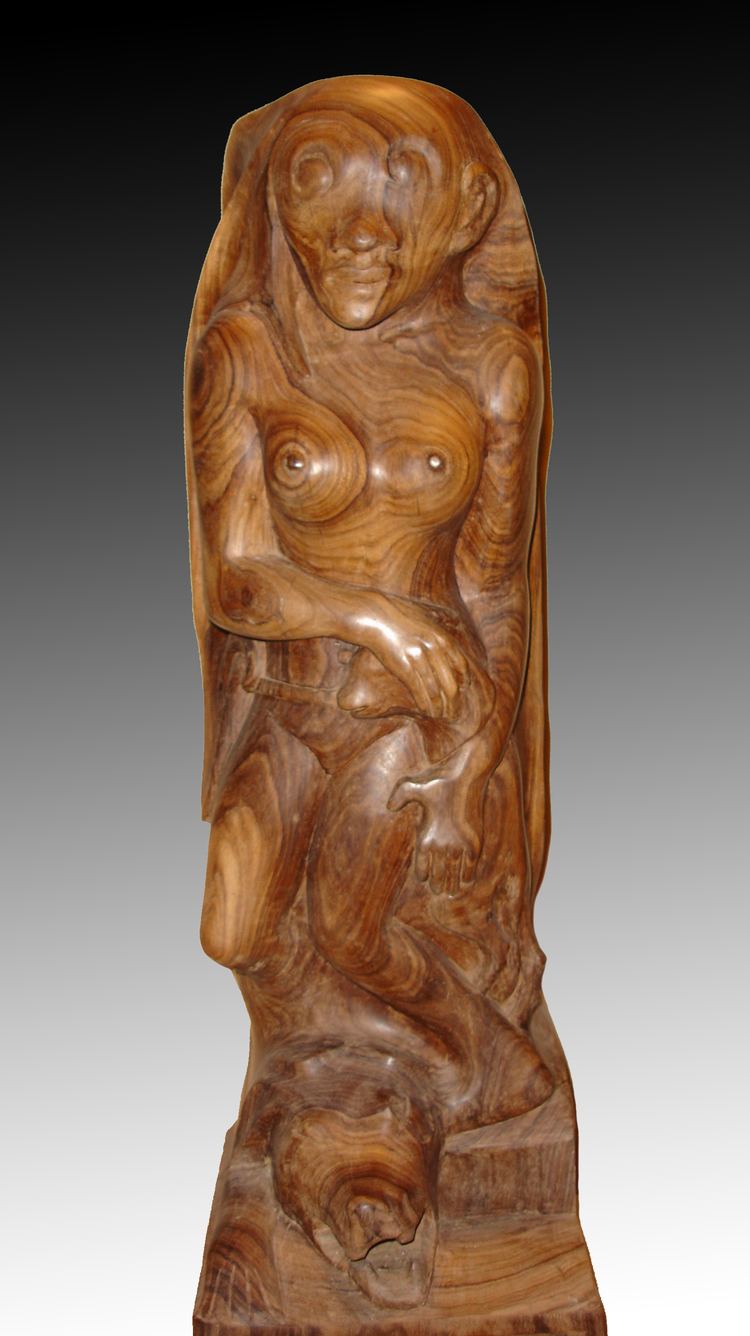
Art historian Christopher Gray mentions three plaster casts, the fissured surfaces of which suggest that they were taken from a prior undocumented wood carving no longer extant. One was given to Daniel Monfreid and now belongs to the Musée départemental Maurice Denis "The Priory" in Saint-Germain-en-Laye. Another version in plaster, with the surface finish of wood, was kept by Gustave Fayet, and subsequently formed part of the collection of his son, Léon. The third version was kept by the artist who made the casts. A number of bronzes were produced, including the version placed on Gauguin's grave at Atuona, cast by the Foundation Singer-Poligna and erected 29 March 1973.
Interpretation
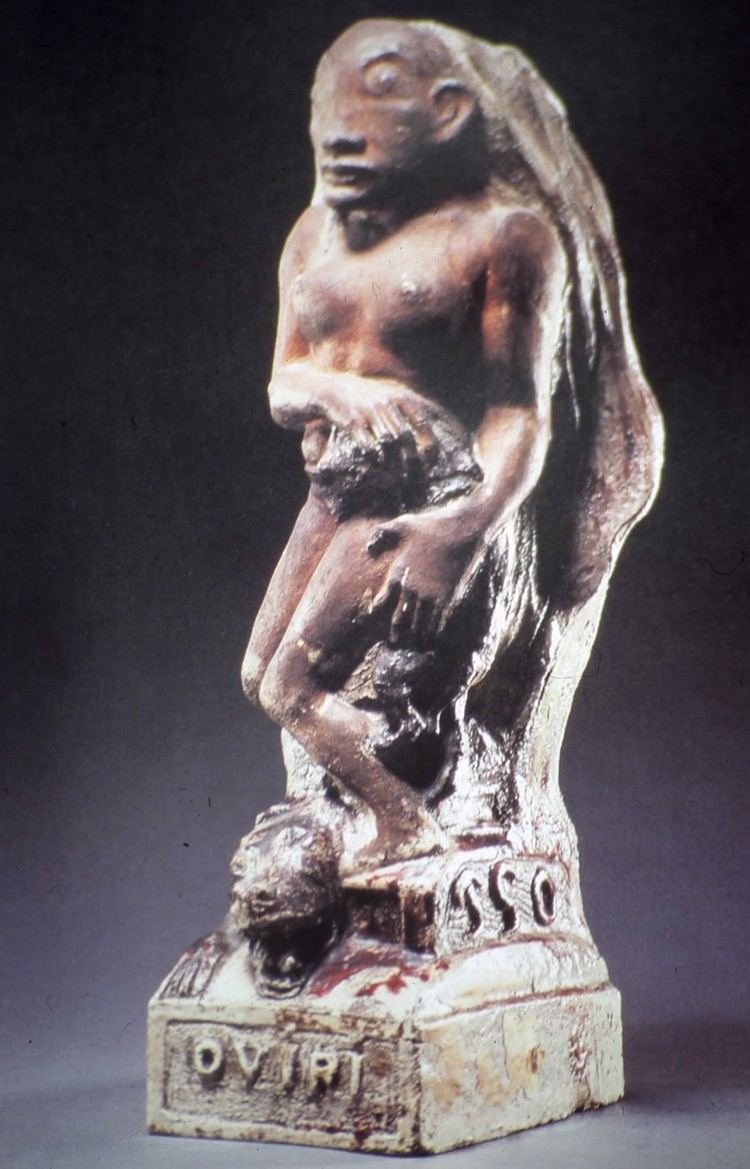
Art historians have put forward various theories as to the seeming multiplicity of meanings inherent in Gauguin's representation. Most obviously the figure invokes Tahitian legend and themes of death and superstition. It reflects the artist's view of female sexuality; a common motif in 19th century art was the connection between long, wild hair and evil femininity. Related is the delight Gauguin took from its alternative title "savage" and the implications of a brutal, bloodthirsty deity, which seems to refer as much to himself as the goddess.
Tahiti deity
Gauguin's figure seems to invoke the Polynesian goddess Hina, depicted by Morice as a Diana-like deity clutching a wolf cub, "monstrous and majestic, drunk with pride, rage and sorrow". He titled an 1894 self-portrait in plaster as Oviri. The original is lost but a number of bronze casts survive. He used double mirrors to capture his familiar Inca profile, the result reprising his Jug in the Form of a Head, Self-Portrait. This was one of the earliest occasions Gauguin applied the term Oviri to himself. "Gauguin sometimes also referred to himself as Oviri, the savage ...", writes Merete Bodelsen. The Stuttgart version of his 1892 oil painting E haere oe i hia (Where Are You Going?) depicts a woman clutching a wolf cub. Pollitt remarks that this stocky, sculptural and androgynous figure gives a first glimpse of Oviri.
Oviri was the title of a favourite Tahitian song – a melancholy tune of love and longing that mentions the subject's "savage, restless heart". It recounts the love between two women for each other, both of whom have grown silent and cold. Gauguin translated the verse in his series of romanticised journal Noa Noa (Tahitian for "fragrance", a written project he undertook to examine his Tahitian experience, which he accompanied with a series of ten woodcuts); the only one of his songs reprinted in the Tahitian newspaper La Guêpes when he became editor. Danielsson believes the song echoes Gauguin's dual attachment to his Danish wife Mette and his then vahine (Tahitian for "woman") Teha'amana, his young native wife and the focal point of Noa Noa.
Colonial experience
Noa Noa contains an account of a journey into the mountains with a young man whom he eventually understands as sexless, leading him to meditate on the "androgynous side of the savage" in his manuscript. Ben Pollitt notes that in Tahitian culture the craftsman/artist, neither warrior/hunter nor homemaker/carer, was conceived androgynously, an ambiguous gender position that appealed to Gauguin's subversive nature. Taylor believes Morice may have been describing Gauguin in his 1897 poem Shining Hina of the Woods as part of two long extracts from their collaboration on Noa Noa. Gray views the sculpture as representing "the expression of Gauguin's profound disillusionment and discouragement".
Noa Noa is part of Gauguin's documentation of his experiences as a colonial visitor to Tahiti in 1891–1893. He first used the term "Noa Noa" to describe the scent of Tahitian women: "A mingled perfume, half animal, half vegetable emanated from them; the perfume of their blood and of the gardenia taitensis, which they wore in their hair". On his return to Paris in 1893, Gauguin was apprehensive about exhibiting his Tahitian works. Noa Noa was to provide the context necessary for the public to comprehend the new motifs presented at his Durand-Ruel exhibition. It was not, however, completed in time for the opening of the exhibition.
Self portrait
Gauguin asked that Oviri be placed on his grave, which seems to indicate that he saw the figure as his alter ego and the fox as changeable in its gender as he was (according to Mathews) and thus symbolic of dangerous sexuality. A number of sources indicate that Gauguin was suffering at the time from a syphilitic rash that prevented him from travelling to Tahiti for several months. She suggests the orifice is a pars pro toto for the woman who infected him.
The anthropologist Paul van der Grijp believes Oviri was intended as an epithet to reinforce Gauguin's persona as a "civilised savage". The artist wrote in his final letter to Morice that "You were wrong that day when you said I was wrong to say I was a savage. It's true enough: I am a savage. And civilised people sense the fact. In my work there is nothing that can surprise or disconcert, except the fact that I am a savage in spite of myself. That's also why my work is inimitable."
Reception and influence
Whether or not the sculpture was to be exhibited at the Salon de la Nationale, it was scheduled for the café proprietor Lévy at 57 rue Saint-Lazare, with whom Gauguin had concluded an agreement to represent him before his last departure for Tahiti. It failed to sell, and Charles Morice was unable to raise public money to acquire it for the nation. Gauguin had thought his only likely interested patron would be Gustave Fayet, who did eventually buy it for 1,500 francs, but in 1905, after Gauguin's death.
Gauguin was celebrated by the Parisian avant-garde after the posthumous retrospective exhibitions at the Salon d'Automne in 1903 and 1906. The power evoked by his work lead directly to Les Demoiselles d'Avignon in 1907. According to David Sweetman, Picasso became an aficionado of Gauguin in 1902 when he befriended the expatriate Spanish sculptor and ceramist Paco Durrio in Paris. Durrio was a friend of Gauguin and held several of his works in an attempt to help his poverty-stricken friend in Tahiti by promoting his oeuvre in Paris.
Art historian John Richardson writes:
The 1906 exhibition of Gauguin's work left Picasso more than ever in this artist's thrall. Gauguin demonstrated the most disparate types of art—not to speak of elements from metaphysics, ethnology, symbolism, the Bible, classical myths, and much else besides—could be combined into a synthesis that was of its time yet timeless. An artist could also confound conventional notions of beauty, he demonstrated, by harnessing his demons to the dark gods (not necessarily Tahitian ones) and tapping a new source of divine energy.
Both Sweetman and Richardson point to the Gauguin Oviri as a major influence. First exhibited in the 1906 Salon d'Automne retrospective, it was probably a direct influence on Les Demoiselles. Sweetman writes, "Gauguin's statue Oviri, which was prominently displayed in 1906, was to stimulate Picasso's interest in both sculpture and ceramics, while the woodcuts would reinforce his interest in printmaking, though it was the element of the primitive in all of them which most conditioned the direction that Picasso's art would take. This interest would culminate in the seminal Les Demoiselles d'Avignon."
In 2006, a bronze version of Oviri sold at Christie's New York for US$251,200.
